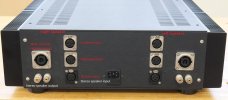I am one of the early adopters of the Danville dspNexus 2/8 and want to give you some impressions. Before doing that, I can tell you that what I don’t know about setting up filters and other parameters in DSP is far more than what I do know. I have been working with DSP for many years to get the best performance out of the speakers I build. In the early days I used miniDSP and Behringer equipment. I then progressed to the DEQX Express II which was a big improvement. A large part of that was the DEQXpert service DEQX has to aid in setting up the system. In the US, their expert is Larry Owens of KRC-US, who helped me when I originally had the system using my Bohlender Graebener RD75s (January and February 2001 audioXpress magazine) with dipole midbass arrays (June and July 2004 audioXpress magazine) and subs, and later twice when I built the “eggs” and then when I moved to a new house.
For my latest set of speakers, the “eggs” (September, October, and November 2018 issues of audioXpress magazine) the DEQX with its six channels was sufficient. When I added the distributed subs to the system (August 2022 issue of audioXpress magazine), I needed two additional channels. I had been waiting for the new DEQX Pre8 Advanced HD Active but had not heard a firm delivery date, so I looked elsewhere.
Richard Hollis of Hollis Audio labs had been speaking about Danville for years and when he mentioned the new dspNexus, I signed up for the EA program. Like DEQX, an advantage of the Nexus is that you have an expert to help you with the setup and trouble shooting. Rich took some of the basic settings from my Express II and gave me a file to load on the Nexus.
As with any early unit, there have been a few annoying things, many of which are because all my equipment is located on a rack in my basement under the dedicated audio room remote from my listening position. However, to make a long story shorter, the audio performance and adjustment capabilities of the Nexus are superb. One of the things that makes a sound system sound more real is what I call texture. With massed voices you can easily hear the differences in the individual voices. With brass instruments, the subtle harmonics of the different instruments clearly makes them sound like a group of instruments and not just a mass of sound. Likewise, strings separate and hall sounds are preserved to give the sound stage depth.
Many people equate a forward frequency presentation with detail, but the real test is to have the detail while not sounding etched. The Nexus is doing that better than anything else I have used. Of course, with great recordings the sound is totally enveloping. But the real test is with the 90% of music that I like that is average in recording quality. For example, my wife and I recently went to the local theater that was playing the live concert film of the Talking Heads “Stop Making Sense”. Before going I put that recording of the performance on my system through the Nexus and was listening at average levels measured C weighted slow with My SPL meter of around 97 dB with peaks over 110 dB, and although quite loud, it was never harsh. I don’t often listen at that level for obvious hearing protection reasons, but it was a good test. Likewise, when listening to Mahler’s 2nd, the detail in the very quiet passages is there followed by clean thunderous peaks as Mahler is wont to do.
It is still early in my use of the Nexus but I will say that I am listening more to all different types of music than I ever have. And my speakers in my acoustically treated room driven by four amplifiers totaling over 6KW are very revealing of any acoustic problems. So far, so good.

